Flora of Inishbofin

Below is an extract from the SAC 000278 synopsis:
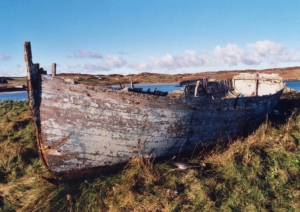 Two-thirds of the island is commonage, where the main habitat type is heath, represented by both dry and wet heath communities. There are many areas of relatively intact dry heath present on Inishbofin, particularly around the middle and eastern quarter of the island. In most places this heath is associated with higher ground and exposed rock outcrops. Some areas of bog and marsh occur, and plantain (Plantago spp.) swards exist on the clifftops. Several small oligotrophic lakes are present. The largest waterbody, Lough Bofin, has a brackish character and is classified as a lagoon. A small area of sand dune occurs at the eastern side of the island. The remainder of the island is under cultivation, with most of the area under grass for pasture, and to a lesser degree, hay. Additionally, a small proportion remains where potatoes and grain-crops are planted.
Two-thirds of the island is commonage, where the main habitat type is heath, represented by both dry and wet heath communities. There are many areas of relatively intact dry heath present on Inishbofin, particularly around the middle and eastern quarter of the island. In most places this heath is associated with higher ground and exposed rock outcrops. Some areas of bog and marsh occur, and plantain (Plantago spp.) swards exist on the clifftops. Several small oligotrophic lakes are present. The largest waterbody, Lough Bofin, has a brackish character and is classified as a lagoon. A small area of sand dune occurs at the eastern side of the island. The remainder of the island is under cultivation, with most of the area under grass for pasture, and to a lesser degree, hay. Additionally, a small proportion remains where potatoes and grain-crops are planted.
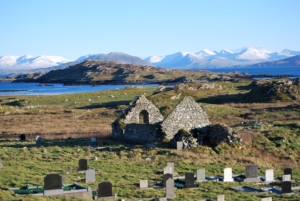
Areas with dry heath support such species as semi-prostrate Heather (Calluna vulgaris), Mat-grass (Nardus stricta), Bell Heather (Erica cinerea), Carnation Sedge (Carex panicea), Viviparous Fescue (Festuca vivipara), Tormentil (Potentilla erecta), Sweet Vernal-grass (Anthoxanthum odoratum), Common Bent (Agrostis capillaris), Heath-grass (Danthonia decumbens), Wild Thyme (Thymus praecox) and Sheep’s-bit (Jasione montana). The rare Spotted Rock-rose (Tuberaria guttata) also occurs. The dry heath habitat generally merges seawards to Plantago sward, and landwards to patches of bog vegetation, Nardus grassland or wet heath with Erica tetralix.
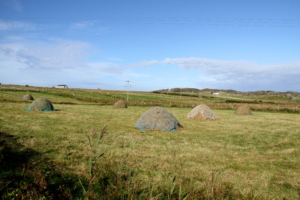 Inishbofin has some good examples of lowland hay meadows. The habitat supports a typically diverse flora with such species as Yellow-rattle (Rhinanthus minor), Red Clover (Trifolium pratense), Creeping Buttercup (Ranunculus repens), Sheep’s Sorrel (Rumex acetosella), Ribwort Plantain (Plantago lanceolata), Hogweed (Heracleum sphondylium), Silverweed (Potentilla anserina), Cocks-foot (Dactylis glomerata), Curled Dock (Rumex crispus), Hedge Woundwort (Stachys sylvatica), Selfheal (Prunella vulgaris), Meadow Vetchling (Lathyrus pratensis), Wild Carrot (Daucus carota), Autumn Hawkbit (Leontodon autumnalis), Purple Loosestrife (Lythrum salicaria) and Bracken (Pteridium aquilinum).
Inishbofin has some good examples of lowland hay meadows. The habitat supports a typically diverse flora with such species as Yellow-rattle (Rhinanthus minor), Red Clover (Trifolium pratense), Creeping Buttercup (Ranunculus repens), Sheep’s Sorrel (Rumex acetosella), Ribwort Plantain (Plantago lanceolata), Hogweed (Heracleum sphondylium), Silverweed (Potentilla anserina), Cocks-foot (Dactylis glomerata), Curled Dock (Rumex crispus), Hedge Woundwort (Stachys sylvatica), Selfheal (Prunella vulgaris), Meadow Vetchling (Lathyrus pratensis), Wild Carrot (Daucus carota), Autumn Hawkbit (Leontodon autumnalis), Purple Loosestrife (Lythrum salicaria) and Bracken (Pteridium aquilinum).
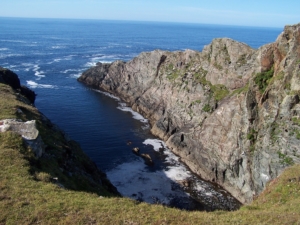
Sea cliffs are found on the western and north-eastern parts of Inishbofin, as well as on Inishshark. In places these support a species-rich vegetation with such species as Wild Angelica (Angelica sylvestris), Thrift (Armeria maritima), Stag’s-horn Plantain (Plantago coronopus), Roseroot (Rhodiola rosea), Bell Heather, Common Bird’s-foottrefoil (Lotus corniculatus), Yorkshire-fog (Holcus lanatus), Dandelion (Taraxacum agg.), Bracken, Primrose (Primula vulgaris), Honeysuckle (Lonicera periclymenum), Common Sorrel (Rumex acetosa), English Stonecrop (Sedum anglicum) and Royal Fern (Osmunda regalis).
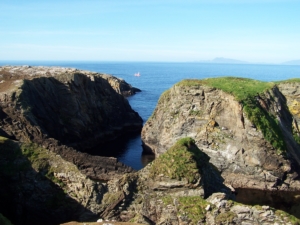
Cliff-top vegetation frequently comprises a short turf usually dominated by Stag’s-horn Plantain, Sea Plantain (Plantago maritima) and Thrift. This often grades inland to Nardus grassland, heath or marsh communities, where such species as Wild Thyme, Allseed (Radiola linoides), Sheep’s-bit, Common Centaury (Centaurium erythraea), Bog Pimpernel (Anagallis tenella), Dandelion, Heath-grass, Kidney Vetch (Anthyllis vulneraria), Marsh Pennywort (Hydrocotyle vulgaris) and a variety of lichens are found.
Lough Gowlanagower is one of a number of small oligotrophic lakes present on Inishbofin. The north-eastern side of the lake supports good communities of Pipewort (Eriocaulon aquaticum) and Water Lobelia (Lobelia dortmanna).
Lough Bofin is an excellent example of an isolated sedimentary lagoon with a cobble barrier. This type of lagoon is relatively rare in Ireland. The lagoon is shallow (c. 2 m) and salinity varies considerably (oligo-euhaline). Seawater enters by percolation and by overtopping the cobble barrier, and large volumes of fresh water enter at times of high rainfall. The lagoon is in an almost completely natural condition, of which there are very few examples in Europe
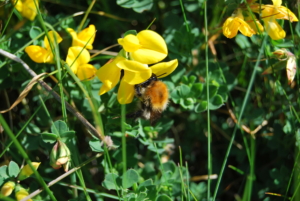 Floristically, the lagoon is very interesting; it supports the rare charophyte Foxtail Stonewort (Lamprothamnion papulosum), a lagoonal specialist which is listed in the Red Data Book and protected under the Flora (Protection) Order, 1999. It also supports two species of Tassleweed (Ruppia maritima and R. cirrhosa) and Chaetomorpha linum, all of which are lagoonal specialists. The vegetation is an excellent example of a Ruppia/ Lamprothamnion community and the plankton appears to contain unusual brackish species of the genus Prorcentrum. The fauna of the lagoon is species-poor, with only one lagoonal specialist, Jaera nordmanni (Order Crustacea), recorded. The absence of other lagoonal specialists may be due to the relative isolation of the site.
Floristically, the lagoon is very interesting; it supports the rare charophyte Foxtail Stonewort (Lamprothamnion papulosum), a lagoonal specialist which is listed in the Red Data Book and protected under the Flora (Protection) Order, 1999. It also supports two species of Tassleweed (Ruppia maritima and R. cirrhosa) and Chaetomorpha linum, all of which are lagoonal specialists. The vegetation is an excellent example of a Ruppia/ Lamprothamnion community and the plankton appears to contain unusual brackish species of the genus Prorcentrum. The fauna of the lagoon is species-poor, with only one lagoonal specialist, Jaera nordmanni (Order Crustacea), recorded. The absence of other lagoonal specialists may be due to the relative isolation of the site.
Inishshark is located to the south-west of Inishbofin and was inhabited up until the 1960s. The main habitats here are heath and rough pasture, and there are no trees.
There is a well-developed Plantago sward on the western side, where there are also some high cliffs. The other sizeable islands in the group are Inishgort, to the southeast of Inishshark, and Davillaun, to the east of Inishbofin.
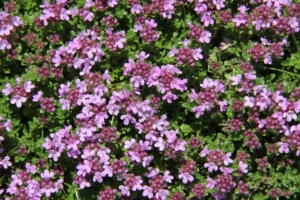 In addition to Foxtail Stonewort there are records from Inishbofin for several other nationally rare Red Data Book species – Spotted Rockrose, for which there are recent records, Wood Small-reed (Calamagrostis epigejos), last seen in 1967, and Marsh Clubmoss (Lycopodiella inundata), last recorded in 1911. The latter two species are also protected under the Flora (Protection) Order, 1999. Darnel (Lolium temulentum), also a Red Data Book species, was recorded from Inishshark in 1875. Three lichen species known in Ireland only from west Galway occur on Inishbofin – Catapyrenium cinerum, Opegrapha paraxanthoides and Lecidella umboella var. alumula.
In addition to Foxtail Stonewort there are records from Inishbofin for several other nationally rare Red Data Book species – Spotted Rockrose, for which there are recent records, Wood Small-reed (Calamagrostis epigejos), last seen in 1967, and Marsh Clubmoss (Lycopodiella inundata), last recorded in 1911. The latter two species are also protected under the Flora (Protection) Order, 1999. Darnel (Lolium temulentum), also a Red Data Book species, was recorded from Inishshark in 1875. Three lichen species known in Ireland only from west Galway occur on Inishbofin – Catapyrenium cinerum, Opegrapha paraxanthoides and Lecidella umboella var. alumula.
